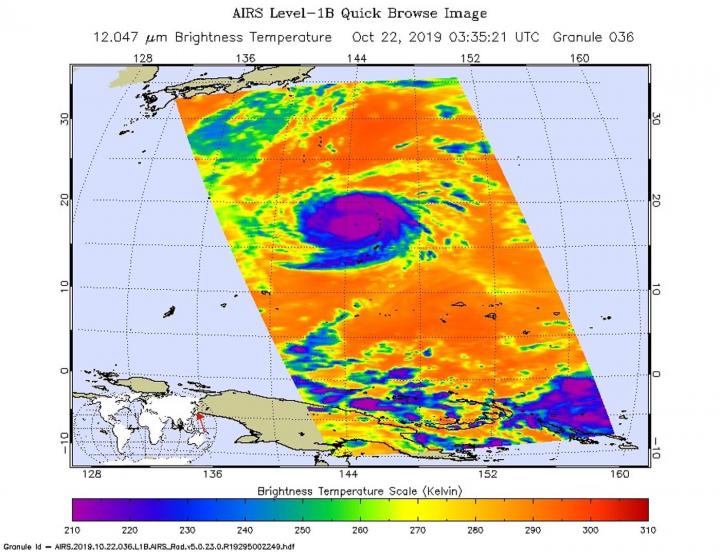
Credit: Credit: NASA JPL/Heidar Thrastarson
Typhoon Bualoi was lashing the Marianas Islands in the Northwestern Pacific Ocean when NASA’s Aqua satellite passed overhead and analyzed the cloud top temperatures to give forecasters insight into the storm’s rain potential.
On Oct. 22, a Tropical Storm Warning remained in effect for the islands of Agrihan, Pagan and Alamagan in the Northern Mariana Islands.
One of the ways NASA researches tropical cyclones is by using infrared data that provides temperature information. Cloud top temperatures identify where the strongest storms are located. The stronger the storms, the higher they extend into the troposphere, and the colder the cloud top temperatures.
Tropical cyclones do not always have uniform strength, and some sides have stronger sides than others, so knowing where the strongest sides of the storms are located helps forecasters. NASA then provides data to tropical cyclone meteorologists so they can incorporate the data in their forecasts.
On Oct. 22 at 0335 UTC (Oct. 21 at 11:35 p.m. EDT) NASA’s Aqua satellite analyzed the storm using the Atmospheric Infrared Sounder or AIRS instrument. AIRS found coldest cloud top temperatures as cold as or colder 210 Kelvin (purple) which is minus 81 degrees Fahrenheit (minus 63.1 degrees Celsius) around the center. NASA research has shown that cloud top temperatures that cold indicate strong storms that have the capability to create heavy rain.
The AIRS infrared imagery also hinted at an eye, but the eye was more apparent in the AIRS microwave imagery. The Joint Typhoon Warning Center estimated that the eye is about 8 nautical miles wide.
At 11 a.m. EDT (1 a.m. CHST local time/1500 UTC) NOAA’s National Weather Service (NWS) in Tiyan, Guam noted that the center of Typhoon Bualoi was located near latitude 19.7 degrees north and longitude 143.2 degrees east. That puts the eye about 175 miles west-northwest of Agrihan, and about 440 miles north-northwest of Guam.
Bualoi is moving northwest at 16 mph. It is expected to make a slight turn toward the north-northwest with a slight decrease in forward speed over the next 24 hours. Maximum sustained winds have increased to 145 mph. Bualoi is forecast to intensify through Thursday and then begin weakening as it moves in a northerly track.
Hurricanes are the most powerful weather event on Earth. NASA’s expertise in space and scientific exploration contributes to essential services provided to the American people by other federal agencies, such as hurricane weather forecasting.
The AIRS instrument is one of six instruments flying on board NASA’s Aqua satellite, launched on May 4, 2002.
###
For updated forecasts, visit: https:/
By Rob Gutro
NASA’s Goddard Space Flight Center
Media Contact
Rob Gutro
[email protected]
Original Source
https:/




